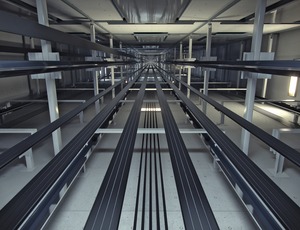
By replacing heavy steel ropes with special carbon-fiber belts that are lighter in weight, Finland's KONE Corp. believes it has altered the course of high-rise elevator systems. Apart from nearly doubling the maximum possible travel height to one kilometer, the new system, launched in London on June 10, significantly reduces rope weight and energy consumption, claims the Espoo-based KONE, which is the world's second-largest elevator and escalator maker. The technology advancement comes at a price premium, which KONE will not divulge.
Weight reduction has been the key aim of the nine-year development of the patented KONE UltraRope system, says Johannes de Jong, the company's head of technology for major projects. As buildings get taller, elevator “rope weight can mount up to 65% to 70% of the total moving mass when payload remains at below 10%,” he adds.
With an eye on the high-rise market, KONE launched its new system a day ahead of the Chicago-based Council on Tall Buildings and Urban Habitat's (CTBUH) 2013 international conference in London.
The new system essentially replaces steel ropes with 2.5-centimeter-wide by 0.5-cm-thick belts comprising four cores of carbon fiber embedded in epoxy resin with a high-friction surface. In a 400-meter-tall building with 10 elevators, the belts would reduce rope weight by over 90%, to under 12 tons. That weight reduction would save 130 MW-hours of electricity annually, claims de Jong.
Operationally, the system is less vulnerable to building sway in high winds, potentially eliminating the need to reduce elevator speeds during storms, says de Jong. While steel ropes in elevator shafts tend to resonate with the swaying motion of tall buildings, carbon belts vibrate at higher frequencies, which avoids the buildup of uncomfortable movements, he explains.
Downtime also will be reduced by the elimination of oil lubricants and the extended working life of carbon-fiber belts, which KONE claims is double that of steel's. And the belts' reduced weight is expected to ease initial installation and periodic replacement, adds de Jong.
Kone began developing the carbon-fiber system in 2004, collaborating with the Netherlands Liftinstituut, Amsterdam, says Guiseppi Bilardello, KONE's senior vice president for technology and research and development. The work included full-scale testing in a 333-m-deep shaft in a limestone mine at Lohja, some 40 kilometers west of Espoo.
One of the biggest challenges was simulating the material's behavior as it ages, Bilardello adds. The system now satisfies relevant European and U.S. codes, says de Jong.
Helping to launch the new system in London, Anthony Wood, CTBUH's executive director, thinks KONE has taken “a huge step” in elevator design. “It's the first time since Elisha Otis cut the steel rope on the safety elevator in the mid-19th century that we have seen an elevator pulled by something other than steel rope,” he says. UltraRope “has the potential to revolutionize the tall-building elevator industry,” he says.
But the impact on building design will be less dramatic, adds Wood. “I don't think we're going to start to see differently shaped buildings as a result of this technology,” he says.
Nevertheless, by improving the efficiency of vertical transportation in high-rises, the system has the potential to save space—for example, by eliminating "sky lobbies," he suggests.
From the building-design perspective, KONE's technology is “interesting, but I wouldn't put it in the revolutionary category,” says Julian Olley, global vertical-transportation design leader at Arup Group, London. The economic benefits likely will be “marginal in terms of the overall cost of the building,” he adds.
While agreeing that UltraRope will significantly extend elevator travel heights, he thinks only a tiny fraction of future buildings will be mega-tall.
After years of work, KONE is more bullish about the system's prospects. De Jong cites CTBUH projections for numerous buildings above 200 m and several reaching 1 km. He also predicts that the adoption of the new technology will start slowly, building up to account for the majority of the company's orders in a decade, mainly in the Asia Pacific region and the Middle East.


Post a comment to this article
Report Abusive Comment